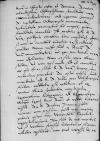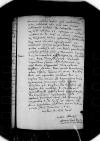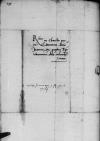Ad negotia generosi domini ⌊castellani Gedanensis⌋ promovenda voluntate promptus fui magis quam facultate paratus. Id gratum esse Reverendissimae Dominationi Vestrae quodque conatum boni consulat, etiam si non in omnibus eventus responderit, gaudeo. Nemo mihi fuit a Reverendissima Dominatione Vestra commendatus, cui ego pro virili mea non affuerim. Nam eo sum erga illam studio, ut non ipsi modo, sed et omnibus iis, qui cari sunt Reverendissimae Dominationi Vestrae, semper sim inservire paratus.
De cista missa sunt mandata ad Reverendissimam Dominationem Vestram per ⌊Volfgangum Fulder⌋. Reddita esse arbitror et ex animi ⌊illius⌋ sententia conscripta. Exemplum litterarum ad ⌊reginalem maiestatem⌋ legit ⌊reverendissimus dominus⌋ et reddi litteras iussit. De domino ⌊doctore Ioanne⌋ satis mirari non possum, quod non mecum potius quam cum venerabili ⌊capitulo⌋ expostulaverit. Ita fuit de me meritus, ut si verbum fecisset, libenter ⌊ei⌋ fuerim allodio cessurus. Non erat necesse de re nihili tantas excitare tragoedias. Venit [is] nuper ad me in templo et questus est [de] venerabili ⌊capitulo⌋, quod se mecum committere voluerit. Ego penes vener[abile] ⌊capitulum⌋ nullam esse culpam video, sed dixi ⌊illi⌋ non oportuisse eum ad ⌊maiestatem reginalem⌋ confugere, modo significationem aliquam voluntatis suae mihi dedisset, libenter cessurum i[lli] me fuisse, qui tam bene sit de me in morbo meo curando meritus. Sed ego ⌊illum virum⌋ esse bonum mihi persuade[o], nisi quod de potestate interdum exit.
Quid responderit ⌊maiestas reginalis⌋, nondum scio. Sumus nunc omnes vehementer Hungaricis rebus occupati, ⌊ipsa⌋ prae ceteris ut mater. Ex eo fit, ut puer Reverendissimae Dominationis Vestrae tardius absolv[atur]. Narravit mihi dominus ⌊Grabia⌋, quod paru[m] ⌊ei⌋ gratae acciderint litterae Reverendissimae Dominationis Vestrae, neque necessarium se existimare, ut respondeat semper, si quid ab ea scribitur asperius. „Ne ⌊regiae quidem maiestati⌋ atque adeo neque Deo, inquit, par[cit], si quando commovetur”. De me quoque nonnulla est asperius locuta; sed cur e[go][] homuncio meliore velim esse condicione quam potentes alii, quos iam omnes subiugasse videtur?
De ⌊Alexandro⌋ nihil ex ⌊urbe⌋ allatum est. Ceterum et mandatum mittitur Reverendissimae Dominationi Vestrae, et salvus conductus. Ex ⌊Hungaria⌋ tristia afferuntur: ⌊Ferdinandus rex⌋ arces aliquot expugnavit ac ulterius semper progreditur. ⌊Regina⌋ ⌊Budae⌋ conclusa est, non datur eggrediendi potestas. ⌊Filius eius⌋ a ⌊Turcarum caesare⌋ rex declaratus esse dicitur ⌊Hungariae⌋, ⌊Mailad⌋ vero rex ⌊Transilvaniae⌋. ⌊Valachi⌋ ⌊vayvodam⌋ suum obtruncarunt, in eius locum elegerunt ⌊Alexandrum⌋ ⌊Bohdani⌋ filium. Mori prius decreverunt, quam iugum ⌊Turcarum⌋ ferre. Baschae duo cum exercitu, Sandiaci duo, a ⌊caesare Turcarum⌋ ad ⌊regem Persarum⌋ defecerunt. ⌊Vormacia⌋ rebus infectis discessum est. Crastino die legatus ad ⌊regem Romanorum⌋ mittitur, dominus ⌊Andreas Czarnckowski⌋, scholasticus Cracoviensis. De Cracoviensi episcopatu quid cogitent principes, nemo scit.
Commendo me gratiae Reverendissimae Dominationis Vestrae ac annum illi hunc ineuntem felicem precor.



